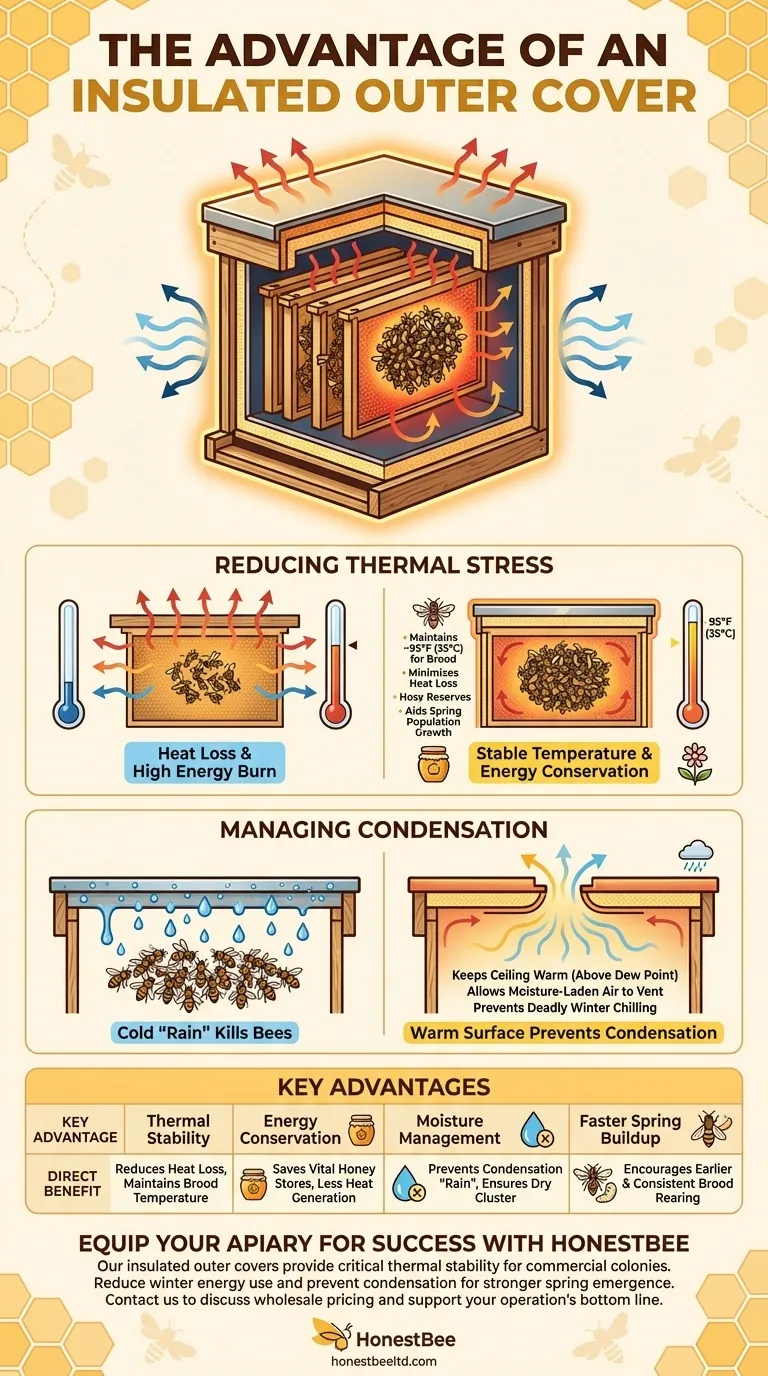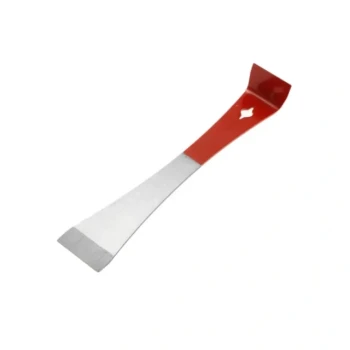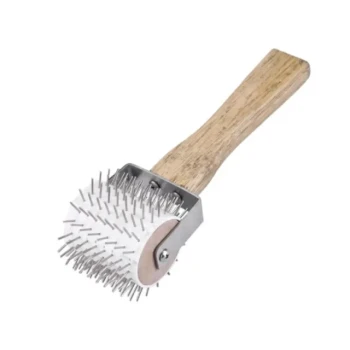The primary advantage of an insulated outer cover is to provide an additional layer of warmth and protection for your beehive. It helps the colony maintain a stable internal temperature, which is especially critical for surviving the winter months.
The core benefit of an insulated cover isn't just adding warmth, but creating a more stable microclimate within the hive. This reduces the energy your bees must expend on temperature regulation, directly impacting their winter survival, spring buildup, and overall health.

The Core Principle: Reducing Thermal Stress
An insulated outer cover works by slowing the rate of heat transfer between the inside of the hive and the outside environment. This acts as a buffer against extreme temperature fluctuations.
Maintaining a Stable Core Temperature
Bees must work constantly to maintain the temperature of their central cluster, keeping it around 95°F (35°C) when brood is present. An insulated cover acts like the wall of a thermos, minimizing heat loss during cold spells.
This thermal stability means the cluster does not have to work as hard or consume as much honey to generate heat through shivering.
Conserving Critical Energy Reserves
A colony's winter survival depends entirely on its stored honey. Generating heat is metabolically expensive, and every degree of heat lost to the environment must be replaced by consuming more of these vital food stores.
By reducing this heat loss, an insulated cover helps the colony conserve its honey, ensuring it has enough food to last until the first spring nectar flow.
Aiding Spring Population Growth
The benefits extend beyond winter. As spring arrives, a stable hive temperature encourages the queen to begin laying eggs earlier and more consistently.
This leads to a faster population buildup, resulting in a stronger, more populous colony ready to take full advantage of spring pollen and nectar sources.
The Unseen Threat: Managing Condensation
Perhaps the most critical function of an insulated cover in winter is not warmth, but moisture management. Condensation is a far greater threat to a wintering colony than cold alone.
Why Moisture is a Killer
As the bees cluster and consume honey, their respiration releases warm, moist air. In a hive with a cold, uninsulated top, this water vapor hits the cold surface, condenses, and drips back down.
This cold "rain" on the winter cluster can quickly chill and kill the bees.
How Insulation Prevents Condensation
An insulated cover keeps the interior surface of the hive's ceiling warmer—ideally, above the dew point.
When the interior surface is warm, the moisture-laden air does not condense. Instead, it can properly exit the hive through a dedicated ventilation opening, such as an upper entrance, keeping the cluster dry and healthy.
Understanding the Trade-offs
While highly beneficial, an insulated cover is a specific tool, and its application requires understanding the context of your climate and management style.
The Need for Proper Ventilation
Insulation without ventilation is a mistake. A completely sealed, insulated hive can trap too much moisture. The cover must be paired with a small upper entrance or shim to allow humid air to escape.
Not a Substitute for a Strong Colony
Insulation helps a healthy, populous colony thrive. It cannot, however, save a weak colony that is low on population, riddled with disease, or already starving. It is a tool to support success, not a cure for failure.
Climate Considerations
In extremely hot and humid climates, an insulated cover can potentially contribute to overheating if the hive lacks sufficient ventilation and shade. Its primary advantage is in regions with cold winters or significant day-to-night temperature swings.
Making the Right Choice for Your Apiary
Ultimately, deciding to use an insulated cover depends on your specific goals and environmental challenges.
- If your primary focus is winter survival in a cold climate: An insulated cover is one of the most effective tools for conserving energy and preventing deadly condensation.
- If your primary focus is a faster spring buildup: The stable temperatures provided by insulation support more robust and consistent brood rearing, leading to a stronger workforce.
- If your primary focus is reducing overall colony stress: Insulation buffers the hive from extreme temperature swings in both winter and summer, allowing the bees to dedicate more energy to foraging, brood care, and health.
By understanding the principles of hive thermoregulation, you can make an informed decision that directly contributes to the success of your colonies.
Summary Table:
| Key Advantage | Direct Benefit for Your Hive |
|---|---|
| Thermal Stability | Reduces heat loss, helping bees maintain brood temperature with less energy. |
| Energy Conservation | Saves vital honey stores by minimizing the need for bees to generate heat. |
| Moisture Management | Prevents condensation 'rain' on the cluster, a major winter survival threat. |
| Faster Spring Buildup | Encourages earlier and more consistent brood rearing for a stronger workforce. |
Equip your apiary for success with HONESTBEE.
Our insulated outer covers are designed to provide the critical thermal stability your commercial colonies need to thrive. By reducing winter energy expenditure and preventing condensation, our equipment helps ensure your bees emerge stronger in the spring, ready for maximum honey production.
As a trusted supplier for commercial apiaries and beekeeping equipment distributors, we understand the demands of large-scale operations. Let us help you build more resilient and productive colonies.
Contact HONESTBEE today to discuss wholesale pricing and how our durable beekeeping supplies can support your operation's bottom line.
Visual Guide

Related Products
- Professional Insulated Winter Hive Wrap for Beekeeping
- Inner Beehive Cover for Beekeeping Bee Hive Inner Cover
- Telescopic Beehive Outer Cover Lid Roof with Galvanised Sheeting for Langstroth Hive and Beehive Outer Cover
- Long Langstroth Style Horizontal Top Bar Hive for Wholesale
- HONESTBEE Professional Multi-Functional Hive Tool with Ergonomic Wood Handle
People Also Ask
- What factors ensure bees stay warm and healthy during winter? Master the 3 Keys to Hive Survival
- Why is insulation important for hives during winter? Ensure Your Bees Survive and Thrive
- How does insulation help bee hives in severely cold weather? Conserve Energy & Ensure Colony Survival
- Should bee hives be insulated? Protect Your Colony from Moisture, Not Just Cold
- What are the benefits of insulated beehives in cold weather? Boost Winter Survival & Spring Productivity



















